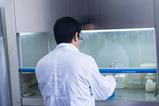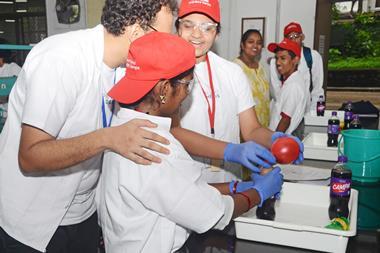Incorporating small amounts of oxidants into methane pyrolysis can significantly enhance carbon and hydrogen production and sustain catalyst activity. Given oxidants are normally considered contaminants in methane pyrolysis, the work calls into question long-standing beliefs about the process.
Methane pyrolysis uses heat to break methane down in the absence of oxygen, generating hydrogen gas and solid carbon. Adding a catalyst lowers the required temperature and speeds up the reaction. It’s a promising route to low- or zero-emission hydrogen, with the added benefit of fitting into existing infrastructure, making it potentially easy to scale. Plus, the solid carbon byproduct can be put to good use.
Working with a fluidised bed reactor filled with Fe/Al₂O₃ catalyst at 750°C, Marco Gigantino, Henry Moise, and colleagues from Stanford University in the US, demonstrated that introducing just 5% carbon dioxide into the methane stream doubled the carbon yield over an hour of operation, with a corresponding hydrogen boost. This addition produced carbon monoxide as a byproduct. Microscopy showed that carbon dioxide enabled the formation of thick carbon layers prone to detachment via fluidisation, ideal for harvesting solid carbon without deactivating the catalyst.
Adding water and oxygen yielded similar benefits. Optimal oxidant-to-methane ratios were determined for both carbon dioxide and water, each yielding over 30% more carbon than methane alone after 14 minutes. When tested on Ni/Al₂O₃ and Co/Al₂O₃ catalysts, the carbon dioxide co-feed continued to outperform methane-only conditions.
Cementite (Fe3C) is a key intermediate in the breakdown of methane. Gigantino and co-workers identified that oxidants speed up the breakdown of cementite, boosting carbon production by regenerating active sites on the catalyst surface. This showed that the catalyst phases are in constant flux. However, at high oxidant levels, cementite transitions into iron oxides, which reduces catalyst activity – highlighting the need to carefully balance oxidant levels for efficient methane pyrolysis.
Raman spectroscopy revealed a subtle shift in the carbon structure: oxidants promoted the removal of amorphous carbon, favouring the growth of graphitic materials, including carbon nanotubes. The team observed that this not only improved catalyst longevity but enhanced the quality of the solid carbon byproduct. They tested oxidant-assisted methane pyrolysis in monolithic reactors and observed that the results mirrored those in the fluidised bed: the experiments yielded higher conversion rates and greater carbon accumulation when using oxidant co-feeds.

The team also studied the potential economic impact of including small amounts of oxidants. According to Gigantino, ‘higher profitability comes from needing to recycle less methane, which improves operating costs and overall process viability. Compared to steam methane reforming, this approach is also significantly less energy-intensive. We’re confident the energy penalty for separating small amounts of carbon monoxide is minor compared to the efficiency gains.’
Chester Upham, a clean energy scientist from the University of British Columbia, Canada, describes the study as ‘a nice and interesting addition to the field of pyrolysis, which is rapidly growing in interest as a reaction and way of producing affordable clean hydrogen.’
















No comments yet